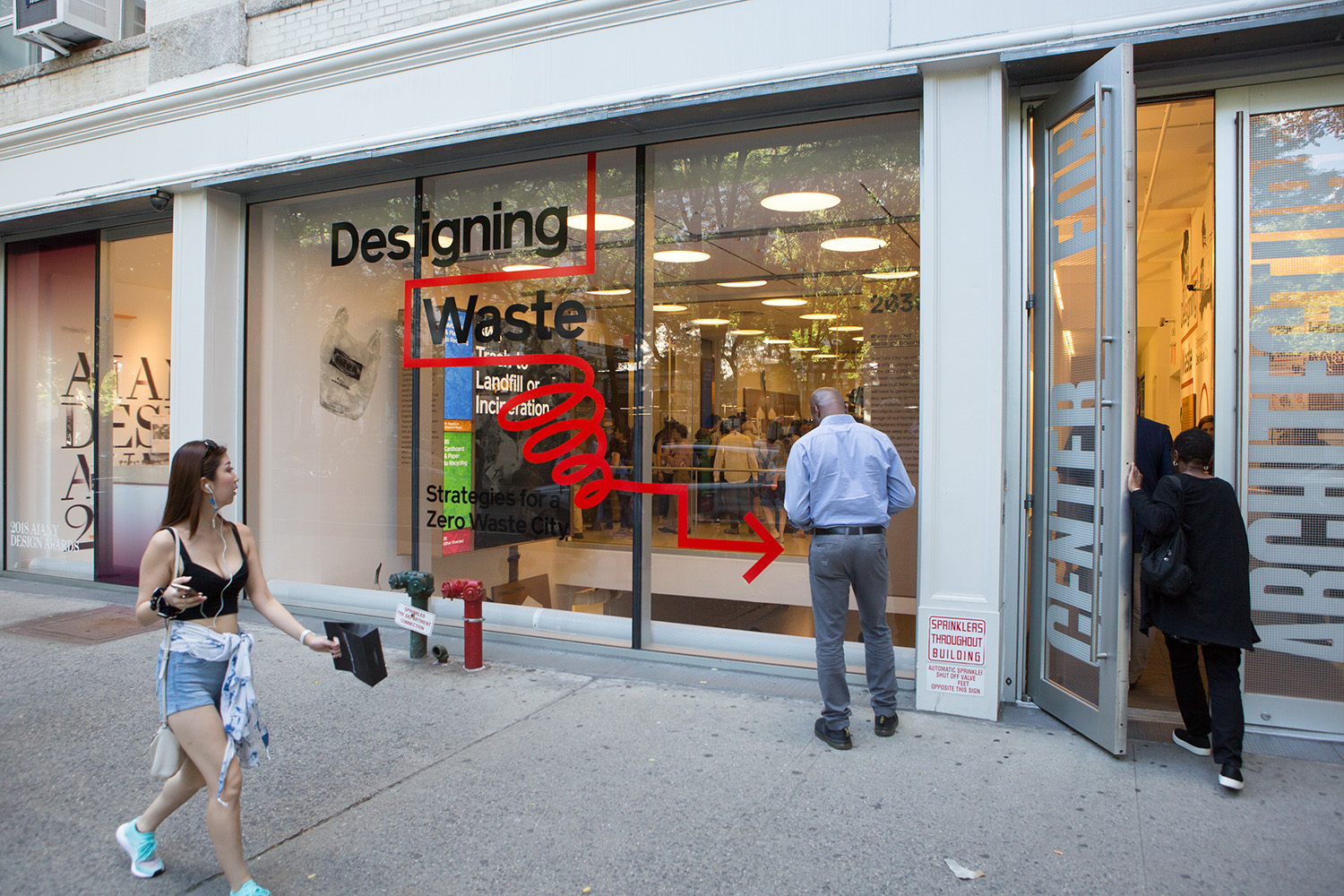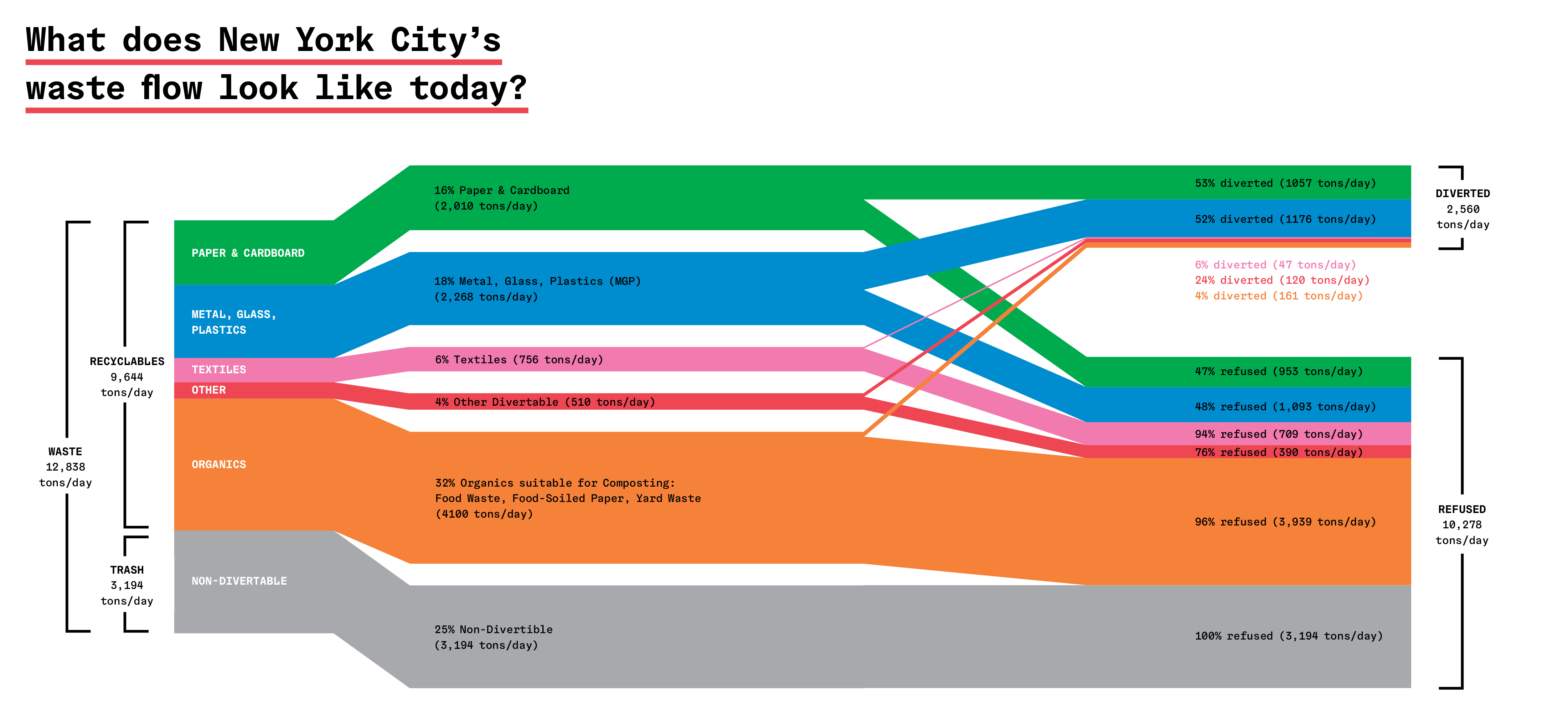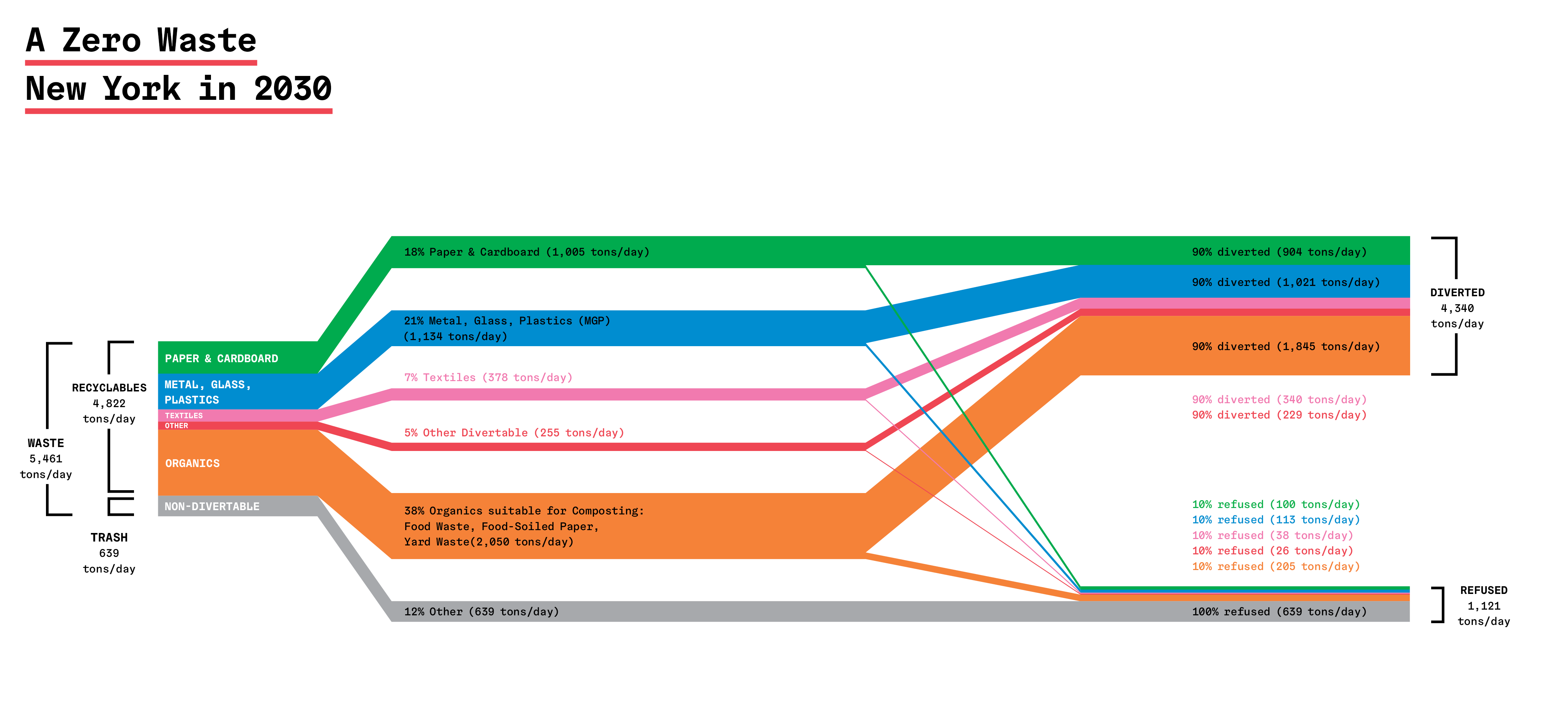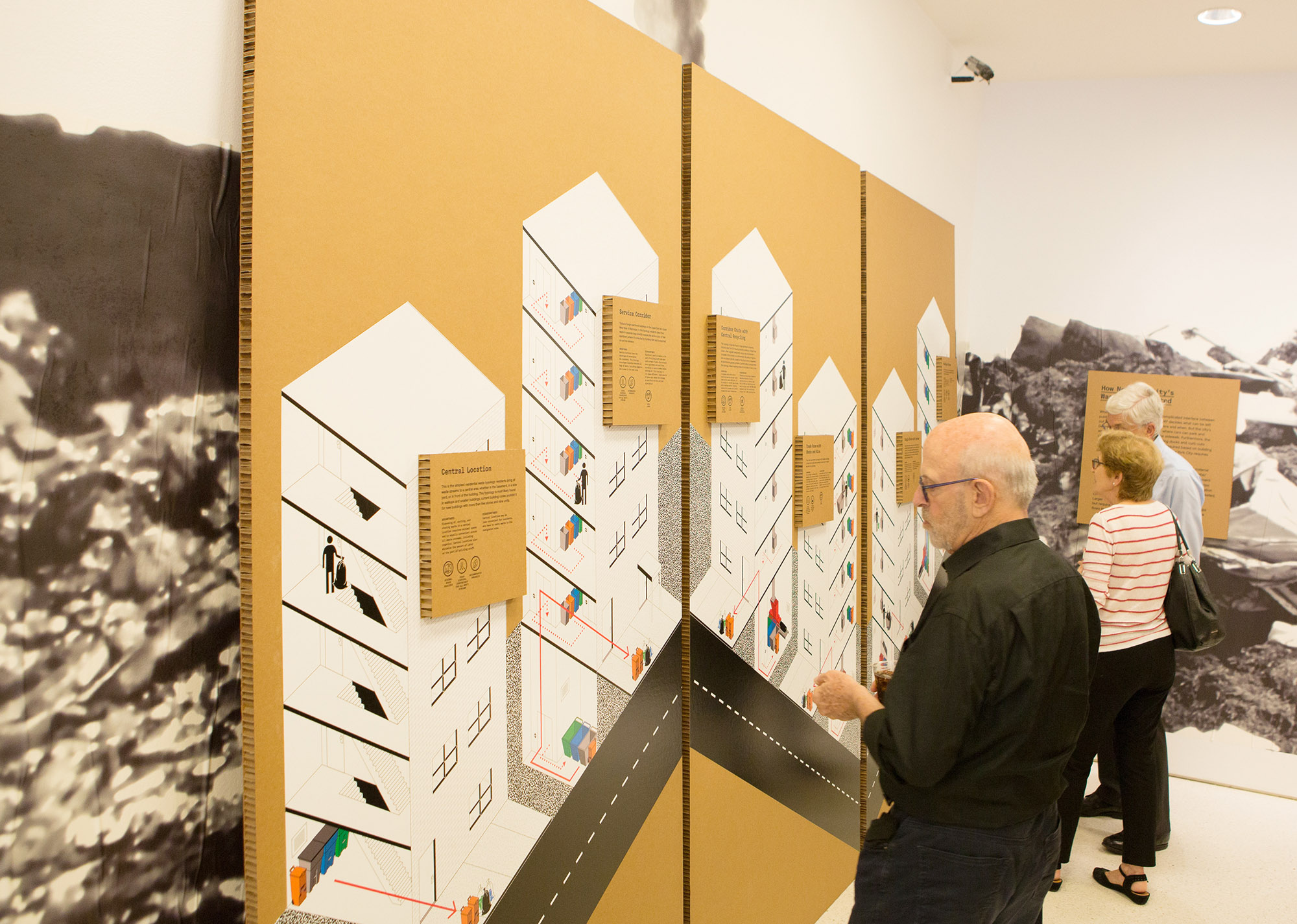New York City has always had a complicated relationship with waste. Even in the seventeenth and eighteenth centuries, as anthropologist Robin Nagle has described, waste physically transformed Manhattan’s shoreline, infilling many parts of the surrounding East River and Hudson Rivers to make new ground—while in the streets, legislation to forbid dumping of rubbish, offal, and chamber pots went largely ignored. By the late 1890s, due to a new mayoral administration and pressures triggered by abominable health and sanitary conditions resulting in uncontrolled cases of smallpox and typhus, the Department of Street Cleaning took on a new civic identity under the meticulous leadership of Colonel George E. Waring Jr., who modeled exemplary methods for urban waste management to clean up the streets—even to the extent that Waring required his teams of street cleaners and carters to don all-white uniforms complemented by tall white hats while they were in the field.1 Today, however, with the average New Yorker generating almost twenty-five pounds of waste a week, and despite the city spending over $2.3 billion on garbage per year, it has fallen behind global leaders in places like Germany and Denmark.2 Manure and dead animals may no longer fill the streets, but trash bags line sidewalks on collection days, often leaking and overflowing—exuding that familiar hot garbage scent particular to New York City summers and revealing a counternarrative to the city’s stories of growth and progress.
In 2015, the city established One New York: The Plan for a Strong and Just City, a strategic plan to address its most pressing challenges including aging infrastructure, job growth, inequality, and climate change. As part of that plan, the city aims to become a leader in solid waste management. The overarching goal is to achieve Zero Waste by 2030, with an aim of reducing the amount of waste the Department of Sanitation (DSNY) sends to landfills by 90 percent, from a 2005 baseline of 3.6 million tons.3 At face value, “zero waste” can be understood as eliminating waste sent to landfills and incinerators, but in a larger sense it describes a circular and metabolic idea of the city—of how waste can be rethought of as raw resources to be recycled, reused, and diverted into new afterlives: discarded food converts into energy, junk mail transforms into pizza boxes, etc.
The recent exhibition Designing Waste: Strategies for a Zero Waste City, organized by New York City’s Center for Architecture and curated by author and journalist Andrew Blum, is premised on the goals of the One New York plan. Blum is best known for his book Tubes: A Journey to the Center of the Internet, which illuminates the vast physical infrastructures and actual spaces of the internet, transforming otherwise highly technical material into a fascinating travelogue of sorts geared toward laypeople. With Blum at the helm, the exhibition’s goal to reveal a ubiquitous, complex, and often overlooked issue like waste takes on a direct journalistic tone geared toward the general public and is treated like a call to action. The Center for Architecture is a publicly facing storefront space on LaGuardia Place that is also home to the professional chapter of New York’s American Institute of Architects and has an audience that is a cross between professionals in the design community and the public. Recently, the Center has emerged as a lively venue for exhibitions, lectures, and programming that aim to tie together the design community with larger social and cultural issues and agencies in the city. Toward helping visitors understand what achieving “zero waste” will entail, the Designing Waste show makes a focused and necessary examination into “a particular segment of the life-cycle of waste: the brief period between when we discard something and when it rolls away on a truck.”4 Blum describes this moment as “when waste is closest to us”—when it exists, forgotten, in the spaces of our homes and workplaces and when it travels, often unseen, through buildings’ corridors, chutes, elevators, and compactor rooms, then onto the sidewalk and into a truck.5 The exhibition itself is urgent and timely, and the material and drawings do considerable work to visualize the immediate issues at stake. The pull between simultaneously satisfying a general audience and design professionals is a challenge of the venue that the exhibition confronts, and ultimately it swings toward raising general public awareness.

Spread across two floors of the Center for Architecture, the exhibition connects the disparate spaces with a consistently bold graphic language and even leads viewers through an unfinished “backstage” storage area of the building, with a permanent installation illustrating the Center’s own sustainability measures and efforts to manage waste. It is organized into roughly four themes that are visually bound together with supergraphic blow-ups of landfill imagery and the Sims Recycling Center in Brooklyn’s Sunset Park. By superimposing wall graphics with thick, recyclable cardboard panels that are both hung and leaned against the walls displaying infographics and wall text, the design produces pockets of immersive space, using the very materials of a traditional recycled aesthetic that are described on the wall. The four themes overlap in content but might loosely be distinguished as (1) where we are and where we want to go; (2) building case studies; (3) labor of waste management; and (4) best practices. Altogether, the exhibition prompts viewers to consider how design might play a role within these waste systems. It nods to the work of Donella Meadows’s systems-based approach, jumping from the different scales of citywide waste networks to the finite scale of sorting one’s own compost.6 This multi-scalar approach raises the show’s central question and tension—is waste a dilemma of management or of design, or both? If it is both—which is what the exhibition suggests—then applying design thinking to concerns of management and civic agency can make a productive impact and enable steps toward new alternatives. From a broader disciplinary perspective, however, the scope of the exhibition at times seems to offer a more limited capacity for design’s potential, favoring the juxtaposition of pragmatic problems with literal solutions.
Upon entering the Center for Architecture, visitors are confronted with a monumental display of various New York City Dumpsters and bins (organics, trash, recycling), as though the sidewalk had found its way inside the exhibition space. They are filled with trash bags and stuffed with cardboard, arranged on a tall, stepped plywood podium that doubles as a physical bar chart by visualizing the waste volume in the bins on top of it. It is the analog companion to the adjacent Waste Calculator, an interactive tool that’s set up immediately in front of the trashy podium. Made up of a plywood bench, table, and set of screens set atop plastic crates, the Calculator displays information about the waste storage capacity of particular building types and makes recommendations for containment strategies to manage the waste stream. This, along with the rest of the exhibition’s content, is based on a portion of the Zero Waste Design Guidelines—a set of design tools, implementation strategies, and best practices compiled by a multi-disciplinary group to “address the crucial role that design plays in achieving NYC’s ambitious goal, outlined in One New York, to send zero waste to landfills by 2030.”7 The Guidelines document is geared toward designers more so than to a general public and is an engaging and in-depth guide to the issues of waste in New York City that both capture and balance the broader issues at stake when dealing with waste in the city as well as the granular scale of those implementation strategies.

In the main atrium of the gallery and on the far wall behind the Waste Calculator are spirited infographics and Sankey diagrams describing New York City’s current status in relationship to zero-waste goals and how waste (including paper, compost, textiles, metals, plastics, and glass) will ideally be diverted going forward if the city is to achieve its goals by 2030. The city has a long way to go, with only 20 percent of waste collected by DSNY that is diverted and does not wind up in landfills.
The information provided points—somewhat timidly—to the broader global story of the systems and externalities involved with the city’s waste management, and the imbalances necessitated by the material stuff of the waste stream. For example, since New York City’s last local landfill, Fresh Kills, shut down in 2001, it now costs the city $350 million a year to transport 75 percent of its waste by rail or truck to towns in the Eastern United States who accept it for disposal. Recyclables, too, are diverted locally but sent to facilities as far-flung as India for recovery.8 So even if New York City achieves zero waste, matters of fossil fuel usage and climate justice still remain critical to address. Moreover, as Myra J. Hird has pointed out, “Waste, of course, doesn’t really go away. Waste flows.”9 In other words, waste materials have extensive life cycles that require a heightened sense of responsibility, as well as a renewed environmental ethics around a “future unknowable vulnerability to harm”—unknowable precisely because the material mixings and afterlives cannot be perceived within known human time scales. Hird’s ontological approach then underscores that responsibility and awareness extend well beyond one’s apartment, building, and even city limits, something that the exhibition neglects to actively highlight, choosing instead to focus on the city’s target goals rather than ethical goals.


The building scale is addressed in great detail; on the walls encircling the Waste Calculator, a series of infographics demonstrate the way in which waste moves through a variety of building types, outlining advantages and disadvantages of each management system. Comprised of axonometric section drawings, they tell the story of how waste might move through a building and then get carted away. For example, one of the more common instances in New York City—the resident of a multi-unit apartment building brings a bag of waste to a corridor, then disposes of it down a chute and into a larger central collection area where members of the building staff sort and place the bags on the street for DSNY sidewalk pickup. The diverse minutiae of this seemingly mundane process is revealed in ten case studies that delineate between cases of single chute versus multiple chute, or the method by which the trash reaches the sidewalk (wheeled bin versus stairs or ramp). The drawings bring to mind the work of Reyner Banham and Buckminster Fuller, who exposed buildings’ environmental controls and technological apparatuses that were otherwise hidden from sight and absent from architectural discourse.10 While the infographics are approachable and explicit, the drawings stop short of challenging our understanding of the issue as more than a technical one tied to specifications. The technical solutions, strategies, and tools offered in the exhibition aim toward the goal of zero waste, yet the technical could have been coupled with the behavioral to communicate how design interventions can change and question everyday cultural practices at the root of the city’s waste problem—disposability and overconsumption.
The conundrum presented here is that if waste is sequestered and dealt with to be out of sight, does it stay out of mind to the point where it is externalized and neglected? While the case studies seem to revel in the mundane details of waste management systems at the building scale, the eye-opening issues that this section quietly points toward operate at the neighborhood and urban scale. In a short wall text (which begs for a mapping visualization), the curator Blum highlights the friction presented by DSNY residential trash collection—a public service—and the over 250 private commercial carters who operate alongside them. In an entangled and often overlapping web of routes, we learn that private carters might pick up from commercial buildings multiple times per day and that multiple carters might service the same block, causing massive congestion and inefficiency and revealing the dense network of the city’s viciously competitive private trash hauling industry.

Continuing onto the lower mezzanine level, the show is brought to life by the introduction of the body and of labor, in a series of films that trail the routines of waste management staff members from four different buildings. Looking at Strivers Gardens in Harlem, we learn that it takes building staff six hours per week collectively to sort and move waste from the compactor room to the sidewalk. We trail the staff member’s journey from a congested compactor room stuffed with trash bags as he pushes a bin through the building’s narrow hallways to the street outside. The heroic efforts of these protagonists bring to mind the unpleasant, unrecognized, obligatory, and repetitious labor of maintenance that Mierle Laderman Ukeles dignified in her “Touch, Sanitation Performance” (1979), during which she shook hands with over 8,500 sanitation works from the DSNY, thanking them for their service.
The final portion of the exhibition focuses on best practices that generally encourage designers to facilitate and incentivize ease and efficiency of waste management systems within the design of buildings. It also illustrates alternative processes that can help designers to re-envision forms of collection. These include pneumatic tubes that could run under and above streets to whisk trash away, prompting images of a Jetsons-like future, and decentralized neighborhood drop-off kiosks for recyclables and textiles that could replace parking spots.
Throughout the exhibition, the curatorial choice to focus so heavily on the building scale makes the design issues at stake appear to be micro-decisions connected to problems of management, while design agency for larger urban and global waste systems goes unaddressed. Beyond implementing certain technologies, designers can also be mobilized with an aesthetic agenda to test how form, organization, and materiality can reveal questions of waste to the public—and perhaps point toward more radical solutions. In the Zero Waste Guidelines, the authors write that instead of having a unidirectional understanding of waste (one that moves from discard to landfill), the guidelines “envision a system where waste is transformed into resources.”11 Indeed, rather than framing waste as an austerity measure or a problem to solve, the underlying possibility the exhibition hints at is rallying designers to reimagine waste through ideas of abundance and alchemy, as a unit of value and a resource that can benefit the greater good.
-
Robin Nagle, Picking Up: On the Streets and Behind the Trucks with the Sanitation Workers of New York City (New York: Farrar, Straus and Giroux), 88–89; 97–111. ↩
-
“Getting to Zero: New York and Waste,” Open House New York, link. ↩
-
Center for Architecture, “Designing Waste: Strategies for a Zero Waste City,” press release, May 17, 2018, link. ↩
-
Center for Architecture, “Designing Waste: Strategies for a Zero Waste City,” link. ↩
-
Donella Meadows, Thinking in Systems: A Primer (London: Earthscan, 2009). ↩
-
The team consisted of Claire Miflin (Kiss + Cathcart), Juliette Spertus (Closed Loops), Benjamin Miller (Closed Loops), and Christina Grace (Foodprint Group). See the report, Zero Waste Design Guidelines, link. ↩
-
New York City Independent Budget Office, “Assessing Progress on the City’s Solid Waste Management Plan,” August 25, 2017, link. ↩
-
Myra J. Hird, “Waste, Landfills, and an Environmental Ethics of Vulnerability,” Ethics and Environment, vol. 18, no. 1 (Spring 2013): 107. ↩
-
Reyner Banham, The Architecture of the Well-Tempered Environment (Chicago: University of Chicago Press, 1984). ↩
Tei Carpenter is an architectural designer, educator, and founder of New York City–based design studio Agency—Agency, which was recently honored with the New Practices New York award by the American Institute of Architects. She is adjunct assistant professor at Columbia GSAPP and the director of the Waste Initiative, an applied research and design platform.

